 |
| © Copyright Zac Sawyer 2015 |
 Frank Hampson (21 December 1918 – 8 July 1985) was a British illustrator, best known as the creator and artist of Dan Dare and other characters in the boys' comic, the Eagle, to which he contributed from 1950 to 1961.
He wrote and drew Dan Dare's 'Venus' and 'Red Moon' stories, plus a complete storyline for 'Operation Saturn'.
However, Hampson drew only part of the 'Saturn' story and his script was altered when he passed the strip to assistants.
Hampson was born at 488 Audenshaw Road, Audenshaw, near to Manchester (now Tameside), and was educated at King George V School, a grammar school in Southport.
Frank Hampson (21 December 1918 – 8 July 1985) was a British illustrator, best known as the creator and artist of Dan Dare and other characters in the boys' comic, the Eagle, to which he contributed from 1950 to 1961.
He wrote and drew Dan Dare's 'Venus' and 'Red Moon' stories, plus a complete storyline for 'Operation Saturn'.
However, Hampson drew only part of the 'Saturn' story and his script was altered when he passed the strip to assistants.
Hampson was born at 488 Audenshaw Road, Audenshaw, near to Manchester (now Tameside), and was educated at King George V School, a grammar school in Southport.
As a child, he loved to draw, and while still a pupil at George V Grammar school, he entered a drawing competition run by 'Meccano' magazine.
Not only did he win a prize for this entry, but the editor was sufficiently amused by his cartoon to ask for more.
Thus, at the age of thirteen, he received his first commission, and for the next two years his work appeared regularly in the journal.
With his School Certificate under his belt, he left school at the age of fourteen and found a job delivering telegrams for the Post Office.
The irregular hours left him with plenty of time to pursue his passion for drawing, and the official G.P.O magazine, 'The Post', soon became a regular outlet for his work.
His father, a policeman, proud of his son's talent, gathered a few of his drawings together one day and showed them to the principal of the local art school.
Between them they decided that - when he wasn't delivering telegrams - Hampson would attend the life-drawing classes there.
But it was to be another two years before he took the final plunge and abandoned his safe 'job with prospects' at the G.P.O. to become a full-time art student at the Victoria College of Arts and Science, Southport.
He was nineteen years old and the year was 1938.
The following year, shortly after the College had presented him with his National Diploma of Design (Intermediate), war broke out. Hampson immediately volunteered for service and during the next six years, he saw action in France and Belgium, and lived through those experiences which would inform and influence much of his future creativity.
His brother Eric was killed in a naval action during the Second World War.
It was wasn't until 1946 that he was finally discharged from the army and free to return to art college.
By then, he had risen to the rank of Lieutenant, and had married Dorothy Jackson, the daughter of a surveying engineer he'd met when taking officer training course in Wales.
The birth of a son, Peter, in 1947, meant that Hampson had to find freelance work to supplement his grant.
One of the jobs he took was to provide illustrations for 'Anvil', a Church of England magazine which had been turned from a simple 'Parish Mag' into a national publication through the entrepreneurial talents of a local parson, the Reverend Marcus Morris.
 |
| Frank Hampson in his Studio |
In 1949, in collaboration with Rev. Marcus Morris, Frank devised a new children’s magazine, the 'Eagle', which Morris took to the Hulton Press.
In April the following year, a revised version of the Eagle hit the bookstalls.
Its most popular strip was Hampson’s 'Dan Dare, Pilot of the Future'.
Like Alex Raymond and Milton Caniff in the U.S., Hampson instigated a studio system where, from his home in Epsom, Surrey, as many as four artists might work on two pages of the strip at any one time.
When Hulton Press was bought up in 1959, and the Eagle moved to a new publisher, Hampson’s studio system was disbanded, mainly due to its cost.
Frank also drew 'The Road of Courage', a carefully researched and meticulously crafted telling of the life of Jesus, with the help of his longtime assistant, Joan Porter, which concluded at Easter 1961.
Hampson then began to devise seven other strip cartoon ideas, which he intended to offer to the Eagle.
Partly through his own mismanagement (he told no-one what he was doing) Longacre Press accused him of breach of contract.
He was forced to resign, his new strips were impounded by the legal department, and he rarely drew for comics again.
The remainder of Hampson’s life was spent working as a freelance commercial artist for various publications.
Hampson was voted Prestigioso Maestro at an international convention of strip cartoon and animated film artists held at Lucca in Tuscany in 1975.
A jury of his peers gave him a Yellow Kid Award and declared him to be the best writer and artist of strip cartoons since the end of the Second World War.
In 1978 he graduated from the Open University
He celebrated by drawing a Dan Dare strip for the University’s internal magazine.The punch line of the script involved the University getting an application from Dare’s nemesis The Mekon.
In ailing health, Hampson died from a stroke and the lingering effects of throat cancer in July 1985, in Surrey, England.

__________________________________________________________
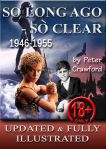

Dan Dare, the space hero of the ‘Eagle’ comic, continued to preoccupy and fascinate Peter, and for the Christmas of 1954 he had managed to nag Jane and John into buying him a ‘Space Station Communications Centre’, which was one of the most elaborate and expensive of the Dan Dare spin-offs that were then flooding the toy shops.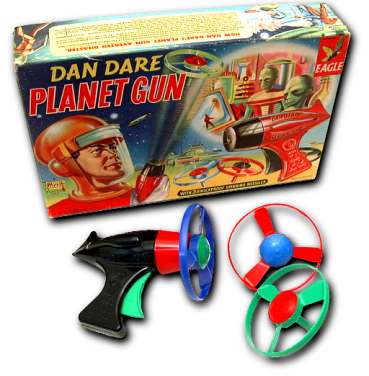 .
.
In many ways, although the Dan Dare serial was set in the then distant future, – the year 2000 – Dan Dare was very much a child of its times.


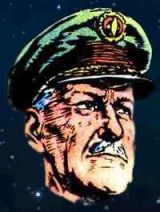

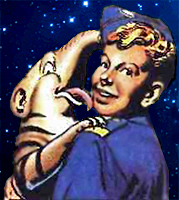 Strangely, none of the men, Dan, Hank – an American, Pierre – a Frenchman, or Lex O’Mally – an Irish naval commander, took the slightest romantic interest in her, and always treated her a just ‘one of the boys’.
Strangely, none of the men, Dan, Hank – an American, Pierre – a Frenchman, or Lex O’Mally – an Irish naval commander, took the slightest romantic interest in her, and always treated her a just ‘one of the boys’.


 Names are strange things, and are often involved in inexplicable co-incidences. Flamer’s first name was Christopher, and as we shall see there was, later on, a very important person called Christopher in Peter’s life. But also Flamer was based on Peter Hampson, Frank Hampson’s young son, and so he shared a name with our Peter, and, looking further back, with Peter Pan.
And like Peter Pan, Flamer never grew up.
When Flamer first appeared in the Eagle, in ‘Prisoners of Space’, he was about thirteen or fourteen, and that was in 1954.
Names are strange things, and are often involved in inexplicable co-incidences. Flamer’s first name was Christopher, and as we shall see there was, later on, a very important person called Christopher in Peter’s life. But also Flamer was based on Peter Hampson, Frank Hampson’s young son, and so he shared a name with our Peter, and, looking further back, with Peter Pan.
And like Peter Pan, Flamer never grew up.
When Flamer first appeared in the Eagle, in ‘Prisoners of Space’, he was about thirteen or fourteen, and that was in 1954.
In 1960, at the end of ‘Terra Nova’, when he should have been twenty, he was still thirteen or fourteen !
And of course, Flamer is still a teenager now – and always will be - still fourteen, and still following his hero, Dan, through the endless reaches of outer space, to the glittering stars, – so Pan lives on in yet another boy – and another story ! .
The characters in the Dan Dare comic strip were from and of the 1950s, but the vision that Hampson had was by no means limited to that decade. Hampson's original inspiration for the adventure of interplanetary travel was seeing the rocket trails of the German V2 missiles as passed over Belgium on their way to London.
With its origins in the vengeance weapons of war, Hampson, however, saw, in the future, a world motivated by the highest ideals.
A world of fairness and decency - and yes - heroism.
It was a world that reached out to other worlds - in the spirit of peace, co-operation and friendship.
Like many, Hampson had been shattered by the horrors of the Second World War, and desperately wished to provide the inspiration to a new generation, (which included his son Peter) to build a new and better world.
Dan Dare is an abiding monument to that dream - and very much calls into question the so-called values of our 'broken', 'politically correct' society.
DAN DARE Stories
____________________________________________
 |
| © Copyright Peter Crawford 2014 |
Dan Dare is a British science fiction comic hero, created by illustrator Frank Hampson who also wrote the first stories, that is, the Venus and Red Moon stories, and a complete storyline for Operation Saturn.
Dare appeared in the Eagle comic story Dan Dare, Pilot of the Future in 1950, dramatized seven times a week on Radio Luxembourg
The stories were set in the late 1990s but the dialogue and manner of the characters is reminiscent of British films of the 1950s.
 |
| Frank Hampson Drawing |
Dan Dare was distinguished by its long, complex story-lines snappy dialogue and meticulously illustrated comic-strip artwork by Frank Hampson and other artists, including Harold Johns, Don Harley, Bruce Cornwell, Greta Tomlinson, Frank Bellamy and Keith Watson.
Dan Dare appeared on the cover of the first issue of the weekly comic strip magazine, Eagle, on 14 April 1950.
 |
| Photos and Drawings - Frank Hampson |
There were two large colour pages of his story per issue.
The artwork was of a high quality, the product of artists in a studio called the 'Old Bakehouse' in Churchtown, Southport, Lancashire.
It had scale models of spaceships, and models in costume as reference for the artists. Occasionally, Eagle incorporated "centrefolds" of the fictional spaceships, such as Dan's ship the Anastasia, reminiscent of cutaway drawings of aircraft in aviation magazines or even Eagle itself.
The story-lines were long and complex, sometimes lasting more than a year.
Later, artwork was produced at a studio in Hampson's house in Epsom, Surrey, where his production line techniques were continued.
Attention was paid to scientific plausibility, the science fiction luminary Arthur C. Clarke acting as science and plot adviser to the first strip.
The stories were set mostly on planets of the solar system presumed to have extraterrestrial life and alien inhabitants, common in science fiction before space probes of the 1960s proved the most likely worlds were lifeless.
The first story begins with Dan Dare as pilot of the first successful flight to Venus.
 |
| Reception at the Venusian Embassy |
Frank Hampson's working habits twice caused him to suffer serious breakdowns in health, leaving his assistants to continue the series.
The first occurred after two episodes of "Marooned on Mercury" (1952), which was taken over by Harold Johns, from scripts by Rev. Chad Varah, a clergyman who had known Marcus Morris in Southport.
Frank Hampson returned to start the following story, "Operation Saturn" (1953), but suffered a relapse after 20 weeks.
Principal art was taken over by new chief assistant Don Harley, who completed the story and its successor, "Prisoners of Space" (the only series to feature extensive work by an artist outside the studio, finishes being provided by Desmond Walduck.
Frank Hampson returned full-time in 1955, starting "The Man from Nowhere" trilogy, which took Dan and his companions outside the Solar System for the first time.
The quality of the strip and its popularity remained high throughout the 1950s.
In the late fifties Eagle's new owners objected to the cost of the studio and the complexity of the stories.
The conflict caused Hampson to leave the strip in 1959, in the middle of a long plot that saw Dan searching an alien planet for his long-lost father.
Production fell to Frank Bellamy, whose modern 3-dimensional style contrasted with Hampson's, despite efforts to smooth the transition by alternating the two pages of the weekly strip between Bellamy and the team of Don Harley and Keith Watson, and freelance artist Bruce Cornwell.
Spacecraft of various designs were presented as the product of inhabitants of various planets. The vehicle most identified with Dan was the winged 'Anastasia'.
Designed by Sondar, it employed both Venusian and Earth space drives.
There were land and air vehicles – in the first stories, cars conform to styling of the time, while some flying machines were based on the design of helicopters of the mid-twentieth century. Also of note was Lex O'Malley's ship, the Poseidon, a versatile craft that could operate as a jet-foil as well as a submarine.
London Transport used overhead monorails and heli-buses in early stories.
Ground transport cars were also drawn with gyroscopes and single wheels.
South of the Flamebelt the Therons had applied their technology to peaceful agricultural purposes including dedicated agricultural land and flying machines.
North of the Flamebelt the Treens perfected low friction/ low energy consumption means of transport including vacuum tube transport (Electro-senders) for long distance travel.
Spacefleet spacesuits had a corselet plate like on Siebe Gorman standard diving suits.
 |
| Space Fleet Space Suit |

Their suit had no life-support backpack; the life-support gear was between two layers of the helmet.
All or most Dan Dare comic pictures were drawn from models or posed humans.
After the first Venus war, Spacefleet spacesuits had propulsor backpacks copied from a Treen or Theron design.
Some other spacesuits such as Blasco's have life-support backpacks.
 |
| Space Fleet Uniform |
Dan Dare became the most popular fictional character in British history during the 1950's, helping the Eagle to sell around three-quarters of a million copies each week and with an at-the-time unprecedented amount of merchandise produced.
Dan Dare was so popular during the 1950's that he even had his own voice-acted radio show on Radio Luxembourg (television was in its infancy at that time in Britain, and radio was still the number one source of in-home entertainment).
Dan Dare and the Eagle were also exported to many countries around the world during this period, with local editions produced in France, Holland, Croatia and Australia to name but a few.
The main reasons for this spectacular popularity were the sheer quality of the story scripting, the brilliant characterisations and the absolutely superb artwork - to this day the 1950's Dan Dare strips are among the very best the world has ever seen.
It is true that the comic was initially created by Marcus Morris and Frank Hampson.
Morris was a 'snobbish' University educated Anglican Vicar, failed Air-force Chaplain and failed Parish 'Priest', who had dabbled in publishing with his parish magazine, 'The Anvil'.
Hampson was 'working class' a failed art student who, after leaving
the Army, was desperate for work.
Morris needed an illustrator for 'The Anvil', and Hampson needed a job, and so the unlikely two teamed up – by necessity rather than any shared sympathies.
However, with 'The Anvil' on its last legs, and very deeply in debt, Morris was desperate to find another option for his obsession with becoming a magazine publisher.
And so Hampson came up with the unlikely idea of 'Dan Dare – Space Fleet Chaplain' – after all, Morris had been an Air-Force Chaplain, even if he wasn't up to the job, and in the end resigned.
Of course 'Dan Dare – Space Chaplain' never even reached even the first issue, and one wonders if the concept was ever seriously intended for publication.
In reality it appears that it was an initial subterfuge to get some into thinking that all the 'spin' about a 'Christian Comic' had some substance.
The 'myth' about the creation of the Eagle, of course, is that it was a riposte to the appalling American 'horror comics', which were supposedly warping the minds – and morals – of innocent little English boys.
The 'Eagle' was, supposedly, a 'Christian' comic for boys.
Now the only 'Christian' item in the Eagle was a strip featuring New Testament stories on the back page – which hardly any boys read.
Interestingly, this specifically 'Christian' strip was not Morris' 'baby', but was included because it gave Hampson a chance to give his version of all the great images in Christian art – the 'Crucifixion', the 'Nativity', the 'entry into Jerusalem' etc – which he did very well – (interestingly, however, Hampson is not remembered for his 'religious' images).
As for encouraging boys to live 'Christian' lives – well that's just part of the myth.
In reality Morris was a womanising, hard drinking 'money grabber', and Hampson was an obsessive monomaniac – and neither of them really cared deeply about Christian morality, although Morris gave superficial lip service to Christian values – until he became editor of 'Cosmopolitan'.
So the 'myths', as such, relate to the supposedly 'saintly' Marcus Morris, and the idea that the Eagle, as thought up by Hampson, was a boy's 'Christian comic'.
And the name ?....
Well the 'myth' teeters between the 'traditional Anglican eagle lectern' in Marcus Morris' church, and an ink-stand in the shape of an eagle in Morris's study.
In reality, the name and the emblem owe nothing to
Christian iconography, but rather are inspired, more prosaically, but
justifiably, by the nearby RAF Woodvale, (on which Hampson based the
Space Fleet HQ), which had an eagle as it emblem (in addition to the
usual RAF eagle), and the motto 'UT AQUILAE VOLENT' - (That Eagles May Fly) - very appropriate ! ...
But what was the Dan Dare 'strip' in the eagle really about ?
That's a question that very few people ask.
Well, to begin with, Dan Dare had practically nothing to do with Marcus Morris.
Dan Dare was the creation, almost solely, of Frank Hampton.
Morris, of course, gave it his approval, and support, when he realised that it was a superb 'money-spinner' – and then took most of the money and the kudos for himself, depriving Hampson of even the copyright !
Hampson's obsession (and it was an obsession), with space flight seems to have been born when he was in the British Army, and came into contact with German rocketry, at the end of the war.
And so, around this obsession, he created a unique 'world' – the world of Dan Dare.
But that world is not quite so simple – or 'clean cut' - as one may imagine.
Within the stories, and the quite amazing 'art', there are trends and themes that are strange, and somewhat unlikely.
One of these themes is that of a faint 'homo-eroticism'.
HOMO-EROTICISM
So, what on earth (or Venus, Saturn, or wherever) is homo-erotic about the work of Frank Hampson ?
MYTHS
The
are a number of myths that 'Eagle Anoraks', and pensioned off 'Astral
cadets' like to 'spin' regarding the origins of Dan Dare and the 'Eagle
Comic'.
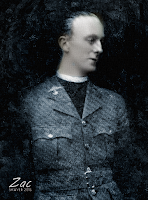 | |||||||
| Marcus Morris by Zac |
Morris was a 'snobbish' University educated Anglican Vicar, failed Air-force Chaplain and failed Parish 'Priest', who had dabbled in publishing with his parish magazine, 'The Anvil'.
 |
| Frank Hampson by Zac |
Morris needed an illustrator for 'The Anvil', and Hampson needed a job, and so the unlikely two teamed up – by necessity rather than any shared sympathies.
However, with 'The Anvil' on its last legs, and very deeply in debt, Morris was desperate to find another option for his obsession with becoming a magazine publisher.
And so Hampson came up with the unlikely idea of 'Dan Dare – Space Fleet Chaplain' – after all, Morris had been an Air-Force Chaplain, even if he wasn't up to the job, and in the end resigned.
Of course 'Dan Dare – Space Chaplain' never even reached even the first issue, and one wonders if the concept was ever seriously intended for publication.
In reality it appears that it was an initial subterfuge to get some into thinking that all the 'spin' about a 'Christian Comic' had some substance.
The 'myth' about the creation of the Eagle, of course, is that it was a riposte to the appalling American 'horror comics', which were supposedly warping the minds – and morals – of innocent little English boys.
The 'Eagle' was, supposedly, a 'Christian' comic for boys.
Now the only 'Christian' item in the Eagle was a strip featuring New Testament stories on the back page – which hardly any boys read.
Interestingly, this specifically 'Christian' strip was not Morris' 'baby', but was included because it gave Hampson a chance to give his version of all the great images in Christian art – the 'Crucifixion', the 'Nativity', the 'entry into Jerusalem' etc – which he did very well – (interestingly, however, Hampson is not remembered for his 'religious' images).
As for encouraging boys to live 'Christian' lives – well that's just part of the myth.
In reality Morris was a womanising, hard drinking 'money grabber', and Hampson was an obsessive monomaniac – and neither of them really cared deeply about Christian morality, although Morris gave superficial lip service to Christian values – until he became editor of 'Cosmopolitan'.
So the 'myths', as such, relate to the supposedly 'saintly' Marcus Morris, and the idea that the Eagle, as thought up by Hampson, was a boy's 'Christian comic'.
And the name ?....
Well the 'myth' teeters between the 'traditional Anglican eagle lectern' in Marcus Morris' church, and an ink-stand in the shape of an eagle in Morris's study.
 |
| RAF Woodvale by Zac |
But what was the Dan Dare 'strip' in the eagle really about ?
That's a question that very few people ask.
Well, to begin with, Dan Dare had practically nothing to do with Marcus Morris.
Dan Dare was the creation, almost solely, of Frank Hampton.
Morris, of course, gave it his approval, and support, when he realised that it was a superb 'money-spinner' – and then took most of the money and the kudos for himself, depriving Hampson of even the copyright !
Hampson's obsession (and it was an obsession), with space flight seems to have been born when he was in the British Army, and came into contact with German rocketry, at the end of the war.
And so, around this obsession, he created a unique 'world' – the world of Dan Dare.
But that world is not quite so simple – or 'clean cut' - as one may imagine.
Within the stories, and the quite amazing 'art', there are trends and themes that are strange, and somewhat unlikely.
One of these themes is that of a faint 'homo-eroticism'.
HOMO-EROTICISM
So, what on earth (or Venus, Saturn, or wherever) is homo-erotic about the work of Frank Hampson ?
Well, for one thing we are not suggesting that Hampson was homosexual.
He was married, (happily or not we do not know), and he had one son, Peter.
And one thing to clear up at this point is the connection between Peter Hampson and 'Flamer' Christopher Spry (and we will be hearing a lot more about 'Flamer' later).
According to the often quoted 'myth', 'Flamer' was based on Peter Hampson.
This is not correct.
Firstly,
Peter was too young when 'Flamer's' character was first created, and
secondly, there is a photograph of the boy on whom 'Flamer' was based.
However, it has not been possible to discover who the boy was - and no one, who may know, is telling.
To return to Frank, however, while he was probably not homosexual, he undoubtedly had homo-erotic tendencies, which can be clearly discerned in some of his illustrations (should we call it art ?), and in the characters and story-lines to be found in the adventures of Dan Dare, as featured in the 'Eagle' comic.
The obvious example, of course, is the relationship that exists between Colonel Dare and 'Flamer' Spry, a cadet from the 'Space Fleet Astral College'.
'Astral College', in case you don't know, is a kind of space-age Eaton, with 'fagging', prefects and uniforms, and of course no girls.
IN THE BEGINNING
We should begin, of course, at the beginning, however, with two men who each have an important place in Colonel Dare's life.
The first is his immediate boss, Sir Hubert Guest, the Space Fleet Controller.
The second is Spacemen First Class Albert (Dig) Digby.
Now the relationship between Dare and Guest is not strictly speaking 'homo-erotic'.
We know that there was a connection between Sir Hubert and Dan's father, back in the early days of space exploration - and this may help to explain how Dan became a colonel in his early twenties.
It should also be remembered that there is an age gap of approximately thirty years between the two men.
Dan's father died when Dan was still a boy, and it seems the Sir Hubert became a substitute father.
It is interesting to note, however, the despite Sir Hubert's gruff manner, and 'stiff upper lip', he appears to be inordinately, and possibly inappropriately fond of his young protégé.
Digby (Spacemen First Class Albert Digby) is a completely different case - or almost.
Like Sir Hubert, he's older than Dan, and also inordinantly fond of his young boss.
'Dig', surprisingly, is married, and has two children, although you hardly ever see him with his family.
Even when Dan has 'leave', Dig tags along with him ('Safari in Space' - with Flamer in tow), so the two men holiday together, with Digby's wife and kids left at home.
Digby's official position is Colonel Dare's 'batman'
In case you don't know, this has nothing to do with the 'caped crusader'.
A 'batman' is a soldier or air-man assigned to a commisioned officer as a personal servant.
Before the advent of motorized transport, an officer's batman was also in charge of the officer's "bat-horse" that carried the pack saddle with his officer's kit during a campaign.
Now apparently Digby is a first class pilot, and on numerous occassion has been offered promotion, however, he prefers to stay a simple 'menial', so that he can stay with his beloved Dan.
Digby, however, also seems to have some 'connection' with young 'Flamer' as, in the 'Posiedon' and 'Galactic Galleon' they 'bunk' together.
'FLAMER' SPRY
Flamer Spry is a
character who was introduced to the Dan Dare strip in the story
'Prisoners of Space'.
Flamer appears in both
the undersea expedition in Lex O’Malley’s submarine 'Poseidon' (The Man from Nowhere) ,
and as a member of the four man Earth Expedition that is sent to the
planet Cryptos, to save the peaceful Crypts from invasion by their
warlike enemies, the Phants ('Rogue Planet').
And it was equally
reasonable for Flamer to be present at the Embassy Reception, where
he enjoyed recognition for his part in the apparent 'defeat' of the
Mekon.
Dan has the task of
going to Cryptos to help the Crypts defend themselves against the
Phants.
But he is persuaded to
relent, and to authorise Flamer’s admission, by a speech from the
boy.
He already spends
almost all his time with a devoted older male, (like Batman and his butler), who has
apparently regularly abandoned his wife and children to serve him.
 |
| 'Flamer' Spry ? |
However, it has not been possible to discover who the boy was - and no one, who may know, is telling.
To return to Frank, however, while he was probably not homosexual, he undoubtedly had homo-erotic tendencies, which can be clearly discerned in some of his illustrations (should we call it art ?), and in the characters and story-lines to be found in the adventures of Dan Dare, as featured in the 'Eagle' comic.
The obvious example, of course, is the relationship that exists between Colonel Dare and 'Flamer' Spry, a cadet from the 'Space Fleet Astral College'.
'Astral College', in case you don't know, is a kind of space-age Eaton, with 'fagging', prefects and uniforms, and of course no girls.
IN THE BEGINNING
We should begin, of course, at the beginning, however, with two men who each have an important place in Colonel Dare's life.
 |
| Sir Hubert Guest by Zac |
The second is Spacemen First Class Albert (Dig) Digby.
Now the relationship between Dare and Guest is not strictly speaking 'homo-erotic'.
We know that there was a connection between Sir Hubert and Dan's father, back in the early days of space exploration - and this may help to explain how Dan became a colonel in his early twenties.
It should also be remembered that there is an age gap of approximately thirty years between the two men.
Dan's father died when Dan was still a boy, and it seems the Sir Hubert became a substitute father.
It is interesting to note, however, the despite Sir Hubert's gruff manner, and 'stiff upper lip', he appears to be inordinately, and possibly inappropriately fond of his young protégé.
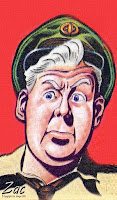 |
| Albert Digby by Zac |
Like Sir Hubert, he's older than Dan, and also inordinantly fond of his young boss.
'Dig', surprisingly, is married, and has two children, although you hardly ever see him with his family.
Even when Dan has 'leave', Dig tags along with him ('Safari in Space' - with Flamer in tow), so the two men holiday together, with Digby's wife and kids left at home.
Digby's official position is Colonel Dare's 'batman'
In case you don't know, this has nothing to do with the 'caped crusader'.
A 'batman' is a soldier or air-man assigned to a commisioned officer as a personal servant.
Before the advent of motorized transport, an officer's batman was also in charge of the officer's "bat-horse" that carried the pack saddle with his officer's kit during a campaign.
Now apparently Digby is a first class pilot, and on numerous occassion has been offered promotion, however, he prefers to stay a simple 'menial', so that he can stay with his beloved Dan.
Digby, however, also seems to have some 'connection' with young 'Flamer' as, in the 'Posiedon' and 'Galactic Galleon' they 'bunk' together.
'FLAMER' SPRY
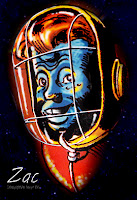 |
| Cadet Urb by Zac |
His precursor was Urb,
a fourteen year old blue Atlantean boy who, for some reason, never
fully explained, was serving on the space-ship that was carrying
Sondar, Dan, Digby and Professor Peabody, on a mission to destroy the 'Red Moon', and which crashed on
Mercury ('Marooned on Mercury').
And like 'Flamer', Urb
had a 'shock' of red hair.
Urb, however, although a charming boy, and excessively 'polite', was blue, (he was an Venusian Atlantine), and despite Hampton's oft lauded 'anti-racialism', and supposed 'political correctness', blue was not really acceptable.
So Urb fades from the scene, to be replaced by a far more acceptable 'white' (but red haired) earthboy, of about the same age, 'Flamer'.
Urb, however, although a charming boy, and excessively 'polite', was blue, (he was an Venusian Atlantine), and despite Hampton's oft lauded 'anti-racialism', and supposed 'political correctness', blue was not really acceptable.
So Urb fades from the scene, to be replaced by a far more acceptable 'white' (but red haired) earthboy, of about the same age, 'Flamer'.
'Flamer', according to
information published outside the comic strip, was born in Middlesex.
He is a cadet at the
Space Fleet Astral College - that space-age Eton to which we have
previously referred..
Unlike all the other
major characters in the Dan Dare stories, nothing else is known about
this boy, other than the fact that he is -in his middle teens when he first meets Dan Dare in 'Prisoners of Space'.
There is, however, a
problem with young 'Flamer'.
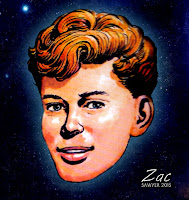 |
| Flamer Spry by Zac |
Now it seems, at the
very least, puzzling that a boy of Flamer's age should have been sent
on the Cryptos Expedition, or Poseidon exploration ?
One
should remember
that he is presented as a young tenage boy, and while it is
possible to understand and appreciate the obvious commercial asset
created by including of character, of a similar age and gender, to that
of the Eagle‘s audience directly in the story, the
fact remains that Hampson never explained why this young boy
should form an essential part of so many of the Dan Dare adventures.
In a less 'realistic'
comic strip it would be easy to ignore the fact that such a young lad
is involved in such 'adventures', but Hampson has set standards of
realism, both in his art and in the construction of his stories,
that prevents one from ignoring the many flaws and inconsistencies in the logic
of his world (and Flamer is just one example)
It was, perhaps,
permissible for Flamer to play an essential role in the story
'Prisoners of Space'.
His introduction into
that story was logical, well-planned, and the result of a perfectly
believable 'accident'.
 |
| The Reception at the Venusian Embassy by Zac |
However, when the alarm
sounded, and Dan went off to deal with the problem, Flamer, quite
rightly was not among the crew.
The fact, however, that
Lex O’Malley who, it appears, has known Dan for maybe a half hour,
does go with the interceptor squadron is strange, to say the least.
The one big question,
however, that’s never answered in all the stories in which he
appears is just who the Junior Cadet nicknamed 'Flamer' Spry is in
the first place.
And at this stage,
perhaps we should consider one of the main problems with regard to
young 'Flamer'.
He appears, apparently
out of nowhere, along with Space Fleet Astral College, and all its
cadets, Senior and Junior, in the first part of 'Prisoners of Space'.
It is not suggested
that Colonel Dare has ever heard of Cadet Spry before 'Flamer’s'
model rocket ship nearly collides with Sir Hubert, but Dan is
sufficiently impressed by the young cadet that he decides that the
only ‘punishment’ for the prank would be a tour of the real
thing.
This scenario, of
course, is perfectly plausible, and considering how well 'Flamer'
conducts himself in what are obviously difficult circumstances, it’s
possibly understandable that Dan might then look upon him as a sort
of protégé.
Taking the above into
consideration, the decision to make a place for 'Flamer' on
O'Malley's 'Poseidon' expedition, which was a non-combat,
search-and-rescue mission, is perhaps understandable and logical.
It is, however, the
events after the 'deep sea' expedition that seems more than unlikely,
and raises some difficult questions.
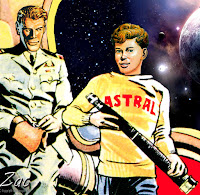 |
| 'Flamer' and Dan by Zac |
The operation involves
a trip across interstellar space, with three volunteers, one of whom
is obviously going to be Digby.
'Flamer', it seems,
puts himself forward as a volunteer, and this can bee seen as an
example of unrealistic, but well intentioned boyish enthusiasm.
The odd result,
however, is that although he is only a thirteen year old boy, he is
accepted, - on an practically suicidal mission, travelling to attempt
avert war five light-years from Earth.
'Flamer', as has been
explained, is an approximately thirteen year old boy at Astral
College, - which is a full-time, military-based establishment and,
like a boarding school pupil, he lives in.
The College is,
therefore, 'in locus parentis'.
In practice, 'in locus
parentis' would mean the Headmaster, and via devolved authority, the
masters.
Ultimately, however,
the responsibility would rest with the Controller of Space-fleet, Sir
Hubert Guest, who is also the supreme authority on Dare’s
Expedition.
Sir Hubert’s initial
response, of course, is to refuse the boy's request.
 |
| The Real Flamer Spry by Zac |
'Flamer' convinces Sir
Hubert, against his own better judgement, to allow him to go.
The speech itself made
up of both positive and negative arguments.
The positive arguments
are what would be expected in the circumstances.
Flamer speaks of the
opportunity, to see, to experience, to grow and to bring back to his
classmates everything he learns.
But it is the negative
argument that is strange.
It’s basically a
statement expressive of the complete, apparent, unimportance of
'Flamer' Spry.
He declares that he is
nothing but a single Astral College cadet.
If he should die, then
little has been lost.
Just one, small,
insignificant figure, who amounts to very little in the great scheme
of things.
It’s a good argument,
but it is difficult to believe that a thirteen year old boy should
have, let alone speak such thoughts.
In its way, the speech
echoes a 'nobility' that is in keeping with Dan Dare himself, but
which seems strange coming from such a young person.
The statement itself,
however, calls our attention to the complete lack of any information
about 'Flamer’, prior to his appearance in 'Prisoners of Space'.
When he describes
himself as nothing, as someone whose death would cause no loss,
create no absence, leave no trace behind, it draws attention to the
simple problem, who is Flamer Spry ?
He must, undoubtedly
have had parents - but who are they, and where are they ?
And whilst there must
have been grandparents, are there any other relatives – such as
brothers and sisters , aunts and uncles – or even cousins ?
Is 'Flamer' Spry really
alone in the world ?
Is there no-one, outside of 'Astral', who has any interest in what might be his fate ?
It should be remembered
that Frank Hampson began Dan Dare with detailed biographies of all its
principal characters.
However, there does not
seem to have been anything similar prepared in respect of 'Flamer'
Spry.
It has been suggested
that perhaps Dan knew the Spry parents, and also 'Flamer' when he was very
young, and that he has taken an avuncular stance in relation to him.
It has also been
suggested that perhaps the Spry parents died when Flamer was young.
Regardless, we are left
with the question of why Earth’s Chief Pilot of Space-fleet spends
so much of his time with a thirteen year old boy - because that
really is the problem.
And one must also
consider that, when Dan gets some leave, he takes 'Flamer' on holiday
with him to the South of Venus (while Peabody, Sir Hubert and O'Malley holiday
separately in Mekonta).
There are, of course,
two other similar characters appearing in boy's comics - 'Batman' and
'Robin' - in reality Bruce Wayne and Dick Grayson.
The 'Dynamic Duo' may
well be presented as portraying an idealised homoerotic life-style,
the adult male, and his under-age boy, spending all their time living
in a house with no female element.
In a similar manner, we
have a relationship between a tall, handsome male bachelor (Dan) who
has demonstrated a lack of interest in any female company (even
Professor Peabody).
 |
| Slim, Gym-toned and Muscled Phants |
And in the Eagle,
beginning with 'Prisoners of Space', this ‘confirmed bachelor’
suddenly starts taking around with him an attractive teenage boy.
Unfortunately, there’s
no definite answer, or a definitive conclusion to this.
One has to consider, of
course, whether any conscious homoerotic undertones were intended.
But with all those
slim, gym-toned and muscled Phants running around, one can't help but
wonder.
ALL text © Copyright Zac Sawyer 2015
reproduced with permission
reproduced with permission
EXCERPT FROM ‘SO LONG AGO – SO CLEAR‘ – Peter’s Biography
THE FUTURE BREAKS IN – THE EAGLE
Friday, the fourteenth of April, 1950, when Peter was five years old, was one of the most important days in that young boy’s life.That was the day that the first copy of the Eagle comic appeared, and was dropped, along with the Middlesex Chronicle, through the letter-box of fifty-five Pears Road, by the paper boy.

Undoubtedly Peter was a bit young for a comic like the Eagle, but his adoptive parents presumably thought it would be good for him, and would probably help Peter with his reading – or more precisely his lack of reading, because at that time Peter could read very little.
In the 1950s the Eagle was a completely new kind of boy’s comic.
The Eagle was the brainchild of the Reverend John Marcus Morris.
Morris was a rather unconventional, Anglican minister, who had started a parish magazine called ‘The Anvil’.
Morris was unconventional in the sense that as a young man he took to canoeing down the Danube with a young friend in the nude; had a forty a day cigarette habit; and was rather over fond of alcohol. In addition, in later life, when he became successful, he regularly indulged in exaggeratedly long business lunches at the best London hotels, and despite being married with children, appeared to see nothing wrong in getting involved with a string of mistresses.
Before succumbing to such temptations, however, Morris developed high hopes for the Anvil, intending it to become a national magazine with the purpose of promoting Christian values in post-war Britain. Unfortunately for post-war Britain, but probably fortunately for a whole generation of boys, the magazine was a complete flop.
Undeterred, Morris turned his moralizing zeal to the question of children’s reading material.
At the time the news-stands were awash with what were generally known as ‘Horror Comics’.
These were essentially imports from the USA, which typically featured stories involving violence, brutal torture, excessive and unnecessary knife and gun play, physical agony, and gory and gruesome crime.
Not surprisingly they were popular with many children, but were a considerable cause of concern to many adults.
Eventually a press campaign was mounted against these publications, and there was even an episode of Britain’s most popular BBC television ‘soap’, the ‘Grove Family’, which featured the families’ youngest child suffering nightmares after reading such a comic.
Eventually Parliament acted, and such publications were banned by law, but not before the
Rev Morris had started work on his new style of comic, which was intended to undo any damage to young minds for which the dreaded ‘horror comics’ may have been responsible.
As a failed independent magazine publisher it was obvious that Morris needed professional help if he was to make a success of his new boy’s comic, and eventually, with the genius of Frank Hampson, the Eagle was published by the Hulton Press.
Now Dan Dare preoccupied our Peter right up until 1959

Dan Dare, the space hero of the ‘Eagle’ comic, continued to preoccupy and fascinate Peter, and for the Christmas of 1954 he had managed to nag Jane and John into buying him a ‘Space Station Communications Centre’, which was one of the most elaborate and expensive of the Dan Dare spin-offs that were then flooding the toy shops.
 .
.
In many ways, although the Dan Dare serial was set in the then distant future, – the year 2000 – Dan Dare was very much a child of its times.
Peter’s Dan Dare Planet Gun
The central character, of course, who had been invented by Frank Hampson, the comic’s artistic director, was Colonel Dan McGregor Dare.
Originally Colonel Dare was to have been a ‘space padre’, in deference to the Rev Morris.
It soon became clear, even before the first publication, that this was not only an impractical character to be the mainstay of the comic, but it was also highly unlikely that boys, to whom the comic was aimed, would be able to identify with such an improbable character.

Colonel Dare, now minus the ‘dog-collar’, was supposedly born in Manchester in 1967, and he attended Rossal School, eventually becoming School Captain, (as our Peter did), and later went to Trinity College Cambridge.
His hobbies were listed as cricket, fencing, riding, painting and model making.
In the 1950s, of course, any boy or man worth his salt was expected to have a number of worthwhile and improving hobbies.

His side-kick was a very different individual.
Albert Fitzwilliam Digby was short and fat, unlike the tall, athletic Dan.
Digby was Dan’s ‘bat-man’.
He was born in Wigan in 1960, and had been brought up by his aunt Anastasia.
Unlike the other characters, Digby was married with four children, Frances, Albert, Mary and Anna.
He was only described as having two hobbies; football and sleeping, but then Digby was a stereo-typical working-class northerner.

Dan’s boss was Sir Hubert Guest, (modelled, in appearance, on Frank Hampson’s father, ‘Pop’), and was the ‘upper class’ commander of the Space Fleet, who was supposedly born in 1943.
Grey haired and distinguished, with a neatly clipped RAF style moustache, Sir Hubert was undoubtedly Dan’s father figure.
There was only one female in the Dan Dare series, and that was Professor Jocelyn Peabody, (who was based on Greta Tomlinson – one of Hampson’s artists).

Miss Peabody was young, slim and very attractive, as well as being very intellectual – well she was a professor and a qualified space pilot !
 Strangely, none of the men, Dan, Hank – an American, Pierre – a Frenchman, or Lex O’Mally – an Irish naval commander, took the slightest romantic interest in her, and always treated her a just ‘one of the boys’.
Strangely, none of the men, Dan, Hank – an American, Pierre – a Frenchman, or Lex O’Mally – an Irish naval commander, took the slightest romantic interest in her, and always treated her a just ‘one of the boys’.
And speaking of boys, there was one boy in the team – Christopher Philip Spry.
Christopher Spry was born in Middlesex, but no date was ever given. In the stories he appears to be about thirteen or fourteen.
Christopher; always known as ‘Flamer’, first appeared in the ‘Eagle’ on 28th May, 1954, when our Peter was about eight years old.
Of course, Hampson was quite clever in introducing a character into the stories who was relatively close to the readers’ own age, & with whom the reader could easily identify.
‘Flamer’ himself was based on Hampson’s son, Peter – another coincidence of names which take us back to Barrie’s eponymous hero – (editor’s note – this is a reference to Peter Pan).
Just as Hampson thought of himself as Dare, and thought of his father ‘Pops’ as Sir Hubert, so Peter Hampson became the inspiration and literally the model – in the sense of artist’s model – for ‘Flamer’ Spry.
Now there were some strange similarities between Flamer Spry, our Peter and the other Peter – (that is Peter Pan), – but we will need to supply some background information for those readers who are not familiar with the Dan Dare stories, in order to make these similarities clearer.

‘Flamer’ firs t appears in the Eagle in a story called ‘Lost in Space’, when he accidentally launches a spaceship containing himself, another, slightly older boy called Steve Valiant, (both are cadets at the Astral College) , and an old mechanic called ‘Groupie’.
.
The trio are captured by the Mekon, (Dan’s arch-enemy), but eventually all turns out well, as it inevitably must.
What is strange is that, although Sir Hubert Guest is distraught at the thought of the two cadets being ‘lost in space’, no mention is made of any actions to contact the boys’ parents or relatives.
As already stated, everything turns out fine in the end, and in subsequent stories Steve Valiant disappears from the scene, excet in 'Reign of the Robots', the sequel to the 'Rogue Planet'.
.

In ‘The Man from Nowhere’, Flamer appears in the opening scenes, wherehe is atte nding a gala reception at the Venusian Embassy in London, along with Steve Valiant, Dan, Digby and Sir Hubert.
He then disappears, during the initial flap, when an alien spaceship suddenly appears in earth orbit.After the spaceship crashes into the Pacific, Flamer, on the insistence of Commander Lex O’Mally, accompanies Dan and Digby on an underwater rescue mission in the Tuscarora Deep. He then disappears from the story again while the alien survivors, the Crypts led by Lero, who have come to Earth seeking help in their fight against the Phants, are rescued.
The story then continues as the ‘Terra Nova’ trilogy, which is the point where Frank Hampson, and Flamer leave the Dan Dare saga.
Now granting that Flamer Spry is just an imaginary character in a boys’ comic, there are still aspects about this young man that impinge on Peter’s story.
Firstly, like Peter, Flamer’s origins are completely unknown.
He is given no date of birth, unlike all the other characters, and all we know is that Flamer was born in Middlesex, which strangely enough is where Peter lived.
Equally, we do not know if Flamer had any brothers or sisters, or even who his parents were.
Was he an orphan, like Peter ? – certainly there were no parents worried and grieving when Flamer is captured by the evil Mekon, or any parents to raise any objections when Sir Hubert decided to allow the boy to go off on a long and dangerous missions out into the unknown, – or parents to consult when Dan decided to take the boy on a holiday to Venus.
 Names are strange things, and are often involved in inexplicable co-incidences. Flamer’s first name was Christopher, and as we shall see there was, later on, a very important person called Christopher in Peter’s life. But also Flamer was based on Peter Hampson, Frank Hampson’s young son, and so he shared a name with our Peter, and, looking further back, with Peter Pan.
Names are strange things, and are often involved in inexplicable co-incidences. Flamer’s first name was Christopher, and as we shall see there was, later on, a very important person called Christopher in Peter’s life. But also Flamer was based on Peter Hampson, Frank Hampson’s young son, and so he shared a name with our Peter, and, looking further back, with Peter Pan. |
| The real 'Flamer' Spry |
And of course, Flamer is still a teenager now – and always will be - still fourteen, and still following his hero, Dan, through the endless reaches of outer space, to the glittering stars, – so Pan lives on in yet another boy – and another story ! .
 |
| V2 (A4) Rocket Take Off |
 |
| Kingfisher Takes Off |
The characters in the Dan Dare comic strip were from and of the 1950s, but the vision that Hampson had was by no means limited to that decade. Hampson's original inspiration for the adventure of interplanetary travel was seeing the rocket trails of the German V2 missiles as passed over Belgium on their way to London.
 |
| Frank Hampson |
DAN DARE Stories
| Dan Dare: The First Story (Sometimes referred to as Pilot of the Future, The Venus Story or Voyage to Venus) | Volume 1, Number 1 Volume 2, Number 25 | 14 April 1950 to 28 September 1951 | Drawn and written by Frank Hampson. |
| The Red Moon Mystery | Volume 2, Number 26 Volume 3, Number 11 | 5 October 1951 to 20 June 1952 | |
| Marooned on Mercury | Volume 3, Number 12 Volume 3, Number 46 | 27 June 1952 to 20 February 1953 | Drawn by Frank Hampson and Harold Johns. |
| Operation Saturn | Volume 3, Number 47 Volume 5, Number 21 | 27 February 1953 to 21 May 1954 | |
| Prisoners of Space | Volume 5, Number 22 Volume 6, Number 18 | 28 May 1954 to 6 May 1955 | Drawn by Desmond Walduck. |
| The Man From Nowhere | Volume 6, Number 19 Volume 6, Number 47 | 13 May 1955 to 25 November 1955 | |
| Rogue Planet | Volume 6, Number 48 Volume 8, Number 7 | 2 December 1955 to 15 February 1957 | Drawn by Frank Hampson and Don Harley. |
| Reign of the Robots | Volume 8, Number 8 Volume 9, Number 4 | Drawn by Frank Hampson and Don Harley. |
____________________________________________
click below for the full text (with lavish illustrations) of the
of the biography of Peter Crawford - a meditation on childhood.
'Peter - the early years'
WARNING:
18+ only - features explicit descriptions of adult themes.



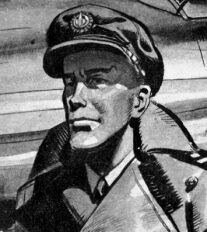

Nice overview, I was looking for a uniform diagram, totally forgot there had been one in Spaceship Away XD
ReplyDelete